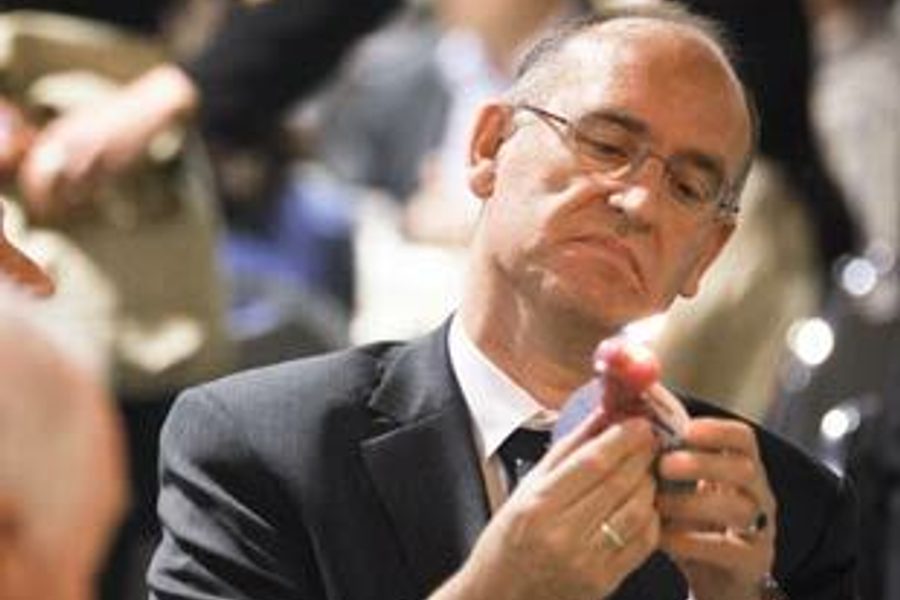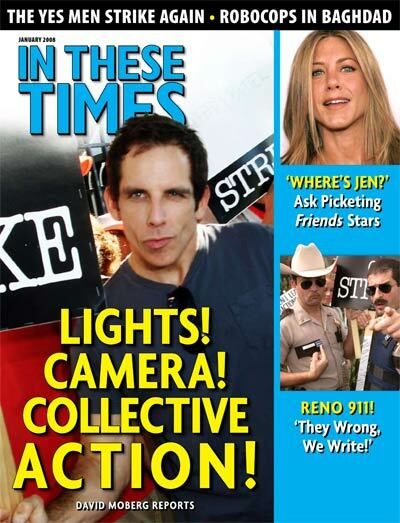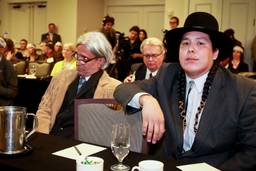Inside the Beast:
Lifelines, Lifetimes and Timelines: Hoisting Ourselves up the Fossil Chain
The Yes Men

What follows is a transcript, obtained by In These Times, of a Keynote luncheon attended by 300 oilmen. The luncheon was part of GO-EXPO, Canada’s largest oil and gas conference, held in Calgary, Alberta in June. It speaks for itself.
S. K. Wolff, a policy analyst at the National Petroleum Council (NPC) and the alternative energy program adviser at ExxonMobil, steps to the podium.
Ladies and gentlemen, I’m very sorry [ExxonMobil ex-CEO and current NPC head] Lee Raymond couldn’t make it today – he’s in Washington, discussing a landmark NPC study before he publicly announces the study’s conclusions later today.
But I am very pleased to give you a sneak preview of that study, which shows that the United States and Canada must expand production from the Alberta oil sands by a factor of five within five years, and prescribes precisely the sort of government non-interference that will make this a reality.
I’m especially pleased that ExxonMobil will be playing a key role in that policy, by developing a renewable energy source that will actually benefit from our development of conventional fuels, while providing a fall-back position for energy sustainability under any conditions that arise.
But first I need to say how wonderful it is to see, on all the faces here today, the childlike exuberance of a great industry in full flower, biting deep into all of life’s opportunities, savoring that life to the fullest.
And why not? After all, our product has made possible everything we see around us – even the food on our tables. Without oil, at least 4 billion people would starve – and those of us left would have a very tough time.
But I’m not here today to pat us all on the back: I’m here to speak of Plan Bs. Because the dire situation I’ve just mentioned is in fact possible.
As we know, if climate science is right, there’s a growing possibility of global calamities, triggering migration, death, and conflicts on a scale never before seen or imagined. This spiral of trouble would make the oil infrastructure utterly useless, and starvation would become the new black. [Laughter.]
Now we don’t believe this will happen, but as responsible corporate citizens we must consider what we would do to keep fuel flowing. We owe it to ourselves, to our shareholders and to sustainability.
Let’s take a quick trip back to the past.
Five billion years ago, our sun was born. For the next half-billion years, Earth was an awful wasteland. Then one day, matter in its infinite ingenuity discovered a fabulous new way to store energy. Today, we call it life – but it’s really just an incredible solar battery that pushed its way across eons and transformed itself into countless species and left them behind, all the way into this conference hall here today.
One day, a resident of ancient Uruk, in Mesopotamia, made a crucial discovery: other animals were great at storing energy. For the next few thousand years, animals were burned for light and warmth.
Europe’s big innovation here was the discovery of the ultimate energy storehouses – those mighty leviathans of the deep, the whales, which until the late 1800s remained Europe’s primary source of illuminant energy. Then, in the mid-1800s, some folks here in Canada discovered that nature had already done a large part of the work that men were still risking their lives for! At some point in Earth’s history, an asteroid hit and pretty much everything died; the fields of death, ensepulchered by eons, were compressed into great deep oceans … of oil.
This “petroleum,” being so much more abundant than animal oil, made possible an unprecedented scale of market performance, leading inexorably to the panoply of amazing technologies we see in the exhibit halls here today.
Today there are dark forecasts that climate change linked to oil use could lead to massive population loss, migrations and conflicts that would destroy pipelines and oil wells. Without oil, the earth’s carrying capacity could go from 6 billion to as low as 200 million. That would be a great tragedy.
Yet if we can assure an uninterrupted supply of fuel in even the worst of calamities, there will be plenty of ways the market can address the new situation. What we really need is something as plentiful as petroleum, but much less dependent on infrastructure – or something as useful as whales, but infinitely more abundant.
And therein lies the key. Just as the death of ancient life forms meant oil for us today, so, in a fuelless world, the massive hydrocarbon store flowing out of the biosphere could mean a massive new resource – if we know how to tap in. All we need to do is climb back up the fossil chain and close the circle of life.
We’re calling this product Vivoleum. Any biomass whatsoever is quickly and cheaply turned into something close enough to gasoline to run my Escalade on it today. Anywhere biological resources find themselves freed, Vivoleum can grant the at-risk civilization a much-needed income stream.
Unlike all other alternative energy sources, Vivoleum will never encroach on the market’s natural right to continue seeking new pastures. The Alberta oil sands, for example, can continue providing a stimulus to Canada, the United States and the whole global market; and in the event climate change becomes unmanageable, Vivoleum will allow the living superstrate of our precious planet to yield an acceptable future.
It is for all these reasons that the National Petroleum Council is pushing forward a fivefold, government-enabled expansion of oil sands production within the near future, on the one hand, and the full-throttle development of Vivoleum, on the other.
Ladies and gentlemen, I’d like to introduce to you now the head of public relations for the Exxon Vivoleum program, who’s also a special adviser to the National Petroleum Council on Vivoleum: Florian Osenberg. He will explain to you Exxon’s real purpose in coming here today – to honor an individual who’s no longer with us.
Osenberg steps to the podium.
Thank you, Shepard.
Ladies and gentlemen, as you can see, I’m holding in my hand a candle. Right now there are people in the room handing out candles just like this. I want each of you to take one, and then I want you to pass the flame to your neighbor.
Now you might look at your candle and think, “What’s the big deal? It’s just a simple candle.” Well, you’re right. But that’s just the point. Just like petroleum’s liquid subterranean feedstocks, Vivoleum can be rendered into just about anything: paraffin, gasoline, plastic – anything.
But the truly amazing thing is that the Vivoleum in these candles comes from one point-source, made available by a very generous man.
This man, Reggie Watts, was just like… well, maybe not you and me. He was an ordinary person who, as ordinary people sometimes do, did something extraordinary. It’s because he gave his all for this product’s development, that we’re honoring him here today.
You’re now going to see how Reggie touched the lives of all those around him, much as he’s now touching all of us here in this room.
Just one word before I start this video. I want to reassure you that Vivoleum is not in any way intended to replace fossil fuels. Rather, it goes hand in hand with them. So long as we continue to develop fossil fuels, there will most likely be bountiful opportunities for Vivoleum.
With no further ado, Reggie Watts!
Video begins. An African-American man with an afro appears on screen, sweeping a loading dock. He is singing to the tune of Debbie Boone’s “You light up my life.” The transcript follows.
Younger businessman: “Reggie was a great worker. He did a great job at our company.”
Woman at desk: “Down to earth, kind hearted, willing to do anything for anybody.”
Maintenance Worker: “He would always be singing because that’s the type of guy he was, always happy.”
Reggie Watts: “I worked in maintenance for a while, cleanup, toxic cleanup. People said I was a-feared of it, but I wasn’t. We had a level three alert. I dunno, I just kind of blew it I guess. After I heard from the Doctor that I was going to die, I felt like I had to have something to live for.”
Younger businessman: “It was a very brave choice that Reggie made”
Reggie: “I’m gonna die anyways. So, yeah, might as well, um, give it a whirl!”
Younger businessman: “Reggie was willing to make that sacrifice for the betterment of humanity, so for that we all salute him.”
Reggie: “I think I would like to be a candle. That would be great.”
At this point Simon Mellor, the conference organizer, comes up on stage and forcibly shuts off the video. Along with a cohort and two security guards, he then escorts Mike Bonanno (Florian) and Andy Bichlbaum (Shepard) to the parking lot. When the Calgary Police arrive more than one hour later, they find the whole story funny; the organizers, however, insist that they charge Andy and Mike with trespassing. The police apologize and assure Mike and Andy that if they don’t pay it, nothing will happen – then ask to shake their hands. And another working day for the guerrilla pranksters, the Yes Men (theyesmen.org), draws to a close.






